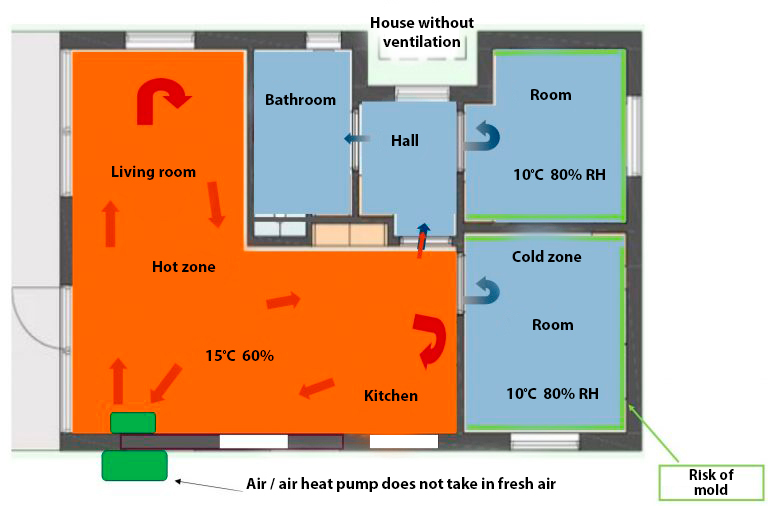Heat pump / Air conditioning or SolarVenti?

If you are considering acquiring one of these or both, you might want to read further. These 2 devices combine very well together – though, the heat pump should never be on its own in a summerhouse.
There are good reasons for this that have never been described before.

A typical air-to-air heat pump for a summerhouse principally heats up one main room (the living room). It doesn’t renovate the air. Rooms, bathroom, etc. are only partially heated. This carries with it the risk of that the warm air in the living room slowly flows into the colder rooms, where moisture levels will rise and be absorbed afterwards by woodwork, etc. Therefore, you should provide these rooms with extra heating or, alternatively, choose a SolarVenti solution.

Effective air flow. Moisturized air slips out through cracks or valves on windows, bathroom or kitchen. Leave the doors between rooms open. Close the chimney damper if there is a wood stove near the air inflow.
Article
Recently, it has become very popular to use air-to-air heat pumps for summer cottages.
It is understandable – but, as many may have experienced, they are not problem-free.
Long story short, the air heat pump doesn’t renovate the air in order to get rid of the moisture, but it just heats the main room where it has been installed up.
The heat reaches only partially the furthest rooms, which would therefore be at a lower temperature. This can and will bring moisture-related problems in the coolest rooms. This is because, even though everything might seem fine in the main room (e.g. living room) where temperature is e.g. 15⁰ C and humidity is 60% at a certain point, it will typically be 5⁰ C cooler in the sleeping rooms. Just this small difference in temperature would be enough to increase the relative humidity level to 80%, with the consequent risk for mold formation. Thus, if you use a heat pump for heating in the living room, you should also heat the rest of the rooms as much, to avoid moisture accumulation there.
Luckily, it has been proved safe and effective to use a solar air collector by SolarVenti to take care of this issue without extra operational costs.
This system will blow relatively dry and fresh air into the house (precisely what the heat pump doesn´t) and extract the moisture effectively out of the house. You can turn off the heat pump completely, since the SolarVenti is able to maintain the house dry without its help.
Turn it on when you get home – or several hours before through your phone. The SolarVenti operates with solar energy for free, and is activated by the sun, so it doesn’t need any calls…
What many don´t know is that these systems also filter pollen and most smoke particles. And what is also important: the filters remain clean thanks to the sun’s heat – sort of like a pyrolysis. When the fan in the system is turned off, the temperature of the filter increases to over 100⁰ C, and has therefore a cleaning effect – good news for allergic people.
A solar air collector doesn´t do anything different to what construction experts advise already: to ventilate and heat up. Both measures are recommended by experts when dealing with humidity in houses and basements.
So, what is it really new about it, and is there something you should be aware of with such systems?
When the warm air comes in through one side of the house/basement and comes out more or less saturated with moisture through the other side, you need to be careful with the fact that the moisture is transported through the house or basement. This phenomenon is known by experts as “moisture movement”. This movement needs to be fast, so that the air doesn’t cool down again and looses the absorbed moisture on e.g. cold walls. The powerful fans of a SolarVenti ensure that this doesn’t happen.
And you get to solve 2, 3 or more persistent issues in one time for little money. No operational costs and a system that will work for more than 15 years without any of the parts needing renovation. The system is suitable for DIY-people.
These systems are distributed locally by the companies found on SolarVenti Dealers
